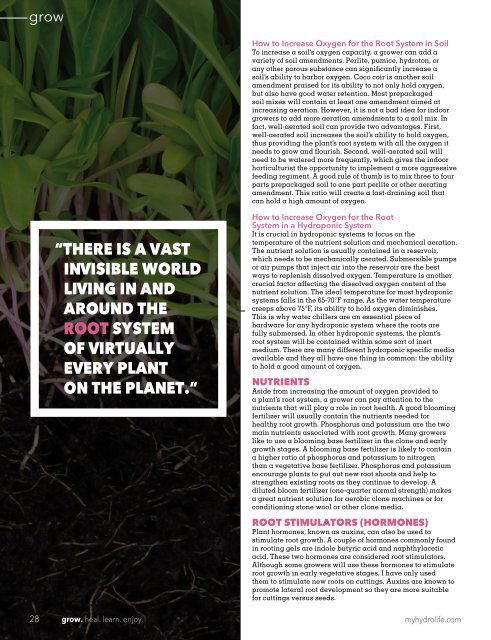Hydrolife Magazine June/July 2017 (USA Edition)
Marijuana, be it medicinal or recreational, still has a long way to go to shake the stigma it has endured for decades in North America. It continues to be an industry struggling to capture acceptance and credibility despite its recent progress. This reality is perhaps just one of the reasons why losing Strain Hunter Franco Loja to cerebral malaria in January.
Marijuana, be it medicinal or recreational, still has a long way to go to shake the stigma it has endured for decades in North America. It continues to be an industry struggling to capture acceptance and credibility despite its recent progress. This reality is perhaps just one of the reasons why losing Strain Hunter Franco Loja to cerebral malaria in January.
You also want an ePaper? Increase the reach of your titles
YUMPU automatically turns print PDFs into web optimized ePapers that Google loves.
grow<br />
How to Increase Oxygen for the Root System in Soil<br />
To increase a soil’s oxygen capacity, a grower can add a<br />
variety of soil amendments. Perlite, pumice, hydroton, or<br />
any other porous substance can significantly increase a<br />
soil’s ability to harbor oxygen. Coco coir is another soil<br />
amendment praised for its ability to not only hold oxygen,<br />
but also have good water retention. Most prepackaged<br />
soil mixes will contain at least one amendment aimed at<br />
increasing aeration. However, it is not a bad idea for indoor<br />
growers to add more aeration amendments to a soil mix. In<br />
fact, well-aerated soil can provide two advantages. First,<br />
well-aerated soil increases the soil’s ability to hold oxygen,<br />
thus providing the plant’s root system with all the oxygen it<br />
needs to grow and flourish. Second, well-aerated soil will<br />
need to be watered more frequently, which gives the indoor<br />
horticulturist the opportunity to implement a more aggressive<br />
feeding regiment. A good rule of thumb is to mix three to four<br />
parts prepackaged soil to one part perlite or other aerating<br />
amendment. This ratio will create a fast-draining soil that<br />
can hold a high amount of oxygen.<br />
“THERE IS A VAST<br />
INVISIBLE WORLD<br />
LIVING IN AND<br />
AROUND THE<br />
ROOT SYSTEM<br />
OF VIRTUALLY<br />
EVERY PLANT<br />
ON THE PLANET.”<br />
How to Increase Oxygen for the Root<br />
System in a Hydroponic System<br />
It is crucial in hydroponic systems to focus on the<br />
temperature of the nutrient solution and mechanical aeration.<br />
The nutrient solution is usually contained in a reservoir,<br />
which needs to be mechanically aerated. Submersible pumps<br />
or air pumps that inject air into the reservoir are the best<br />
ways to replenish dissolved oxygen. Temperature is another<br />
crucial factor affecting the dissolved oxygen content of the<br />
nutrient solution. The ideal temperature for most hydroponic<br />
systems falls in the 65-70°F range. As the water temperature<br />
creeps above 75°F, its ability to hold oxygen diminishes.<br />
This is why water chillers are an essential piece of<br />
hardware for any hydroponic system where the roots are<br />
fully submersed. In other hydroponic systems, the plant’s<br />
root system will be contained within some sort of inert<br />
medium. There are many different hydroponic specific media<br />
available and they all have one thing in common: the ability<br />
to hold a good amount of oxygen.<br />
NUTRIENTS<br />
Aside from increasing the amount of oxygen provided to<br />
a plant’s root system, a grower can pay attention to the<br />
nutrients that will play a role in root health. A good blooming<br />
fertilizer will usually contain the nutrients needed for<br />
healthy root growth. Phosphorus and potassium are the two<br />
main nutrients associated with root growth. Many growers<br />
like to use a blooming base fertilizer in the clone and early<br />
growth stages. A blooming base fertilizer is likely to contain<br />
a higher ratio of phosphorus and potassium to nitrogen<br />
than a vegetative base fertilizer. Phosphorus and potassium<br />
encourage plants to put out new root shoots and help to<br />
strengthen existing roots as they continue to develop. A<br />
diluted bloom fertilizer (one-quarter normal strength) makes<br />
a great nutrient solution for aerobic clone machines or for<br />
conditioning stone wool or other clone media.<br />
ROOT STIMULATORS (HORMONES)<br />
Plant hormones, known as auxins, can also be used to<br />
stimulate root growth. A couple of hormones commonly found<br />
in rooting gels are indole butyric acid and naphthylacetic<br />
acid. These two hormones are considered root stimulators.<br />
Although some growers will use these hormones to stimulate<br />
root growth in early vegetative stages, I have only used<br />
them to stimulate new roots on cuttings. Auxins are known to<br />
promote lateral root development so they are more suitable<br />
for cuttings versus seeds.<br />
28 grow. heal. learn. enjoy.<br />
myhydrolife.com




![Hydrolife Magazine December 2017/January 2018 [CANADIAN EDITION]](https://img.yumpu.com/59790088/1/190x247/hydrolife-magazine-december-2017-january-2018-canadian-edition.jpg?quality=85)
![Hydrolife Magazine December 2017/January 2018 [USA EDITION]](https://img.yumpu.com/59790042/1/190x247/hydrolife-magazine-december-2017-january-2018-usa-edition.jpg?quality=85)
![Hydrolife Magazine October/November 2017 [Canada Edition]](https://img.yumpu.com/59493562/1/190x247/hydrolife-magazine-october-november-2017-canada-edition.jpg?quality=85)
![Hydrolife Magazine October/November 2017 [USA Edition]](https://img.yumpu.com/59493548/1/190x247/hydrolife-magazine-october-november-2017-usa-edition.jpg?quality=85)
![Hydrolife Magazine August/September 2017 [USA Edition]](https://img.yumpu.com/59236656/1/190x247/hydrolife-magazine-august-september-2017-usa-edition.jpg?quality=85)








